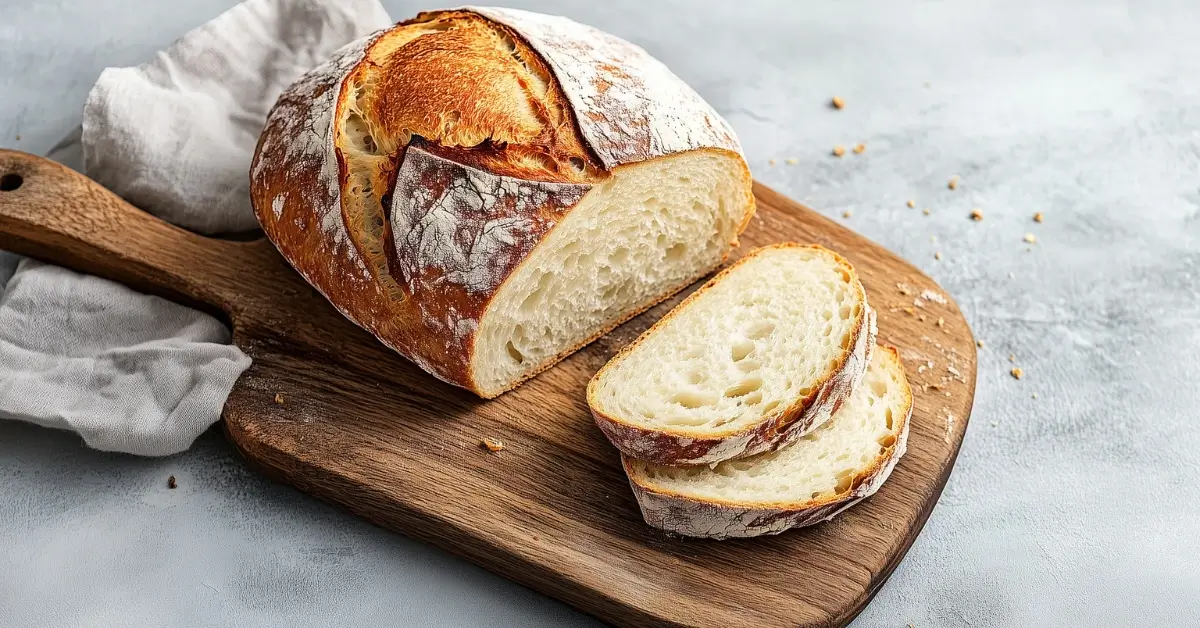If you’re looking to bake a loaf of bread that combines a crispy, golden crust with a soft, airy crumb, this batard bread recipe is for you. Batard bread, with its beautiful oblong shape, is a French classic that’s perfect for everything from a cozy breakfast with butter to serving alongside a rich bowl of soup. What’s even better? It’s surprisingly easy to make, especially when you follow these simple, step-by-step instructions. Whether you’re a seasoned baker or trying your hand at sourdough for the first time, this recipe will guide you to a perfect loaf every time. Are you ready to fill your kitchen with the irresistible scent of freshly baked bread? Let’s dive in!
Table of Contents
1. Why You’ll Love This Recipe
There’s something incredibly satisfying about baking your own bread, and this batard bread recipe is the perfect place to start. With its delicious, slightly tangy flavor and the satisfying crunch of a crisp, golden crust, it’s a loaf that truly stands out. Here’s why you’ll fall in love with making batard bread:
- Easy and Straightforward: While making sourdough bread might sound intimidating, this batard bread recipe is approachable. With just a few simple steps and ingredients, you’ll be on your way to baking a beautiful loaf in no time.
- The Perfect Loaf Shape: The batard’s oblong shape is not just beautiful but practical. It’s the perfect size for slicing, making it ideal for everything from sandwiches to serving alongside your favorite soup.
- Versatility: Batard bread can do it all. Pair it with cheese, dip it in olive oil, or use it to mop up your favorite sauce it’s a versatile bread that works in almost any meal.
- Minimal Ingredients, Maximum Flavor: This recipe uses simple ingredients flour, water, salt, and a sourdough starter but it’s the slow fermentation process that brings out the complex, rich flavors you crave in a great loaf of bread.
- A Satisfying Baking Experience: There’s a certain joy that comes from shaping the dough, scoring the top, and watching it transform into a perfect loaf in the oven. And the best part? The smell of fresh bread filling your kitchen will make all the effort worth it.
Whether you’re a beginner or a more experienced baker, this batard bread recipe will not only give you a gorgeous loaf but will also deepen your appreciation for the art of bread-making. Ready to get started? Let’s dive into the ingredients!
2. Ingredients
This batard bread recipe requires a few simple yet essential ingredients that come together to create a loaf with a perfect balance of texture, flavor, and crust. Make sure to measure each ingredient accurately for the best results.
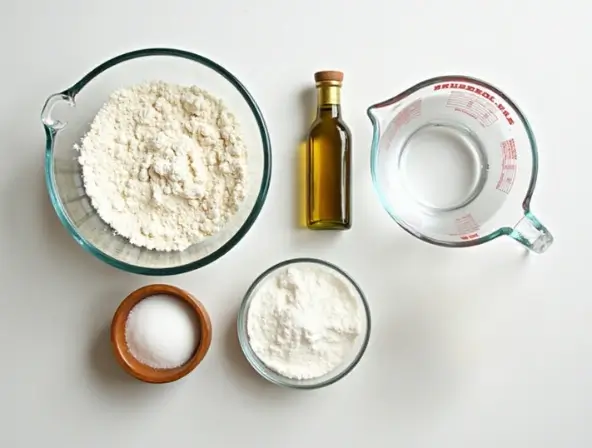
For the Levain (Sourdough Starter)
- 20 g (1 heaping tablespoon) of sourdough starter (100% hydration, float test before using)
The sourdough starter is the heart of the flavor in batard bread. Be sure your starter is active and fresh by performing the float test. If it floats, it’s good to use. - 80 g (⅓ cup) water
Water is essential to hydrate the flour and activate the starter. Make sure it’s filtered or bottled for optimal results. - 80 g (⅔ cup) bread flour
Bread flour is the best choice for batard bread due to its high protein content, which helps create the structure needed for a chewy, airy crumb.
For the Batard Bread
- 100 g (½ cup) levain
The levain, or sourdough starter mixture, will give the bread its signature tang and contribute to the rise and texture. - 360 g (1 ½ cups) water (70°F, ideally)
Lukewarm water is ideal for activating the levain and ensuring the yeast works efficiently during the fermentation process. Aim for a water temperature around 70°F for the best results. - 500 g (4 cups) bread flour
The bread flour will provide the structure and elasticity needed for a strong dough. It helps the bread rise well and develop a satisfying texture. - 2 teaspoons salt
Salt is crucial for both flavor and controlling the fermentation process. It regulates the yeast’s activity, ensuring your bread rises at the right pace while enhancing the overall flavor. - Olive oil (for greasing the bowl)
A small amount of olive oil will keep the dough from sticking to the bowl during the rise. It also adds a subtle richness to the bread’s texture. - 3 tablespoons rice flour (for dusting the banneton)
Rice flour is perfect for dusting the banneton, as it helps prevent the dough from sticking while allowing for a nice, textured surface. If you don’t have rice flour, regular all-purpose flour can work, but rice flour gives the dough a unique finish.
These ingredients may seem simple, but together, they work in harmony to create the perfect batard bread. You’ll love the rustic charm of the dough and the way it transforms as it bakes. Plus, the long fermentation process ensures a flavor profile that’s complex yet approachable. Ready to begin? Let’s move on to the equipment you’ll need to make this bread!
3. Equipment
Before you start, it’s important to make sure you have the right tools on hand. Don’t worry, you don’t need anything too fancy, but a few key pieces of equipment will make the process smoother and help you achieve the best results. Here’s what you’ll need to bake your perfect batard bread:
Essential Tools
- Dutch Oven: A must-have for this recipe. The dutch oven creates a mini-oven effect that traps steam, ensuring you get that perfect, crispy crust and beautifully baked crumb. If you don’t have a dutch oven, a heavy baking pot with a lid can work too.
- Banneton (Proofing Basket): This is essential for shaping the batard and giving it that beautiful oblong shape. It also helps with proper fermentation. If you don’t have a banneton, you can use a well-floured bowl, but the banneton will give you better results.
- Parchment Paper: You’ll need this to transfer the dough from your proofing basket to the hot dutch oven. It also helps prevent the bread from sticking to the pot as it bakes.
- Lame or Sharp Razor Blade: A lame is a tool used to score the top of the dough. Scoring helps the bread expand in the oven and gives it a beautiful look. If you don’t have a lame, a razor blade or even a sharp knife can do the trick.
- Spatula or Dough Scraper: Useful for mixing the dough and gently scraping it from your work surface. You’ll also need it to fold the dough during the fermentation process.
- Bowl (for Mixing Dough): A large mixing bowl is necessary for combining the ingredients. It’s also where the dough will rest and ferment.
- Towel: A clean kitchen towel will be used to cover the dough while it’s resting. This keeps the dough warm and helps it rise.
- Cooling Rack: After baking, a cooling rack is essential to prevent the bread from getting soggy. It allows air to circulate around the loaf, keeping the crust crispy.
With these essential tools, you’ll be well-equipped to handle the steps of this batard bread recipe. Each piece of equipment plays a role in ensuring your bread comes out perfect every time. Now that we’ve got the tools covered, let’s dive into the step-by-step instructions to start baking your beautiful loaf!
4. Step by Step Instructions
Now that you’ve gathered all your ingredients and equipment, let’s dive into the fun part baking your batard bread! Don’t worry, I’ll guide you through each step, and I promise, it’s easier than it looks. Let’s get started.
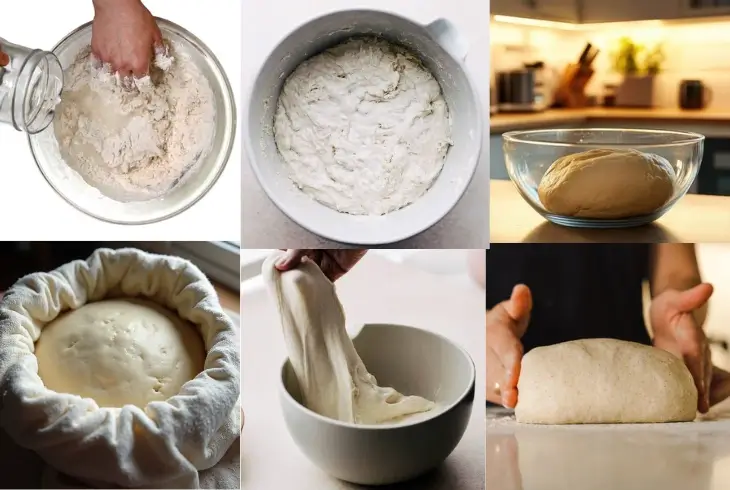
Preparing the Levain (Sourdough Starter)
- Perform a float test: Start by testing your sourdough starter to ensure it’s active. Pinch off about 1 tablespoon of the starter and drop it in a glass of water. If it floats, it’s ready to use. If it sinks, let it ferment a bit longer before testing again.
- Prepare the levain: In a bowl, combine 20 g of sourdough starter, 80 g of water, and 80 g of bread flour. Mix until the ingredients are thoroughly incorporated and the mixture is uniform. Cover the container and let it sit at room temperature for about 12 hours, or until it becomes bubbly and has doubled in size.
Making the Batard Bread
- Autolyse: In a large bowl, mix 100 g of levain with 360 g of water. Stir gently until combined. Gradually add 500 g of bread flour, mixing with a spatula or your hands until there are no clumps of flour. The dough should feel a bit sticky. Cover the bowl with a damp towel or plastic wrap and let it rest for 45 minutes. This process is called the autolyse, which allows the flour to fully hydrate and begin the gluten development.
- Add salt: After the dough has rested, sprinkle 2 teaspoons of salt over the dough. Use your hands or a spatula to mix it in, ensuring the salt is evenly distributed. The dough will become more cohesive and easier to handle as the salt dissolves.
- Grease the bowl: Lightly oil a clean bowl with olive oil to prevent the dough from sticking during its first rise. Transfer the dough into the greased bowl and cover it with a cloth. Let it rest for 45 minutes.
- Folding the dough: Over the next two hours, perform a series of folds every 30 minutes. To fold, wet your hands with water to prevent sticking. Gently pull the dough upwards, then fold it back onto itself. Rotate the bowl slightly and repeat the folding process until you’ve done this four times. Each fold strengthens the dough and helps develop gluten. After the final fold, let the dough rest for 45 minutes.
- Pre-shape the dough: Once the dough has rested, transfer it to a clean, lightly oiled surface. Gently shape the dough into a rough batard (oblong) shape, being careful not to deflate it. Start by folding one-third of the dough from the top down towards the center, then fold the bottom third up towards the center, slightly overlapping the first fold. Pinch the dough along the seam to seal it. Flip the dough seam-side down and, with a gentle tug, create tension by stretching it against the surface about 10 times.
- Final shape: After letting the dough rest for 30 minutes, flip it back over and shape it once again into the batard shape. Dust a banneton (proofing basket) with 3 tablespoons of rice flour to prevent sticking, and place the dough seam-side up in the basket. Cover with a cloth and refrigerate overnight, allowing the dough to rise slowly in the fridge.
Baking the Batard Bread
- Preheat the oven: The next morning, preheat your oven to 450°F (230°C). Place a Dutch oven inside the oven to heat up for about 45 minutes. The Dutch oven will help create a steamy environment, which is essential for a crisp crust.
- Score and transfer: After the dough has chilled overnight, remove it from the fridge. Lay a piece of parchment paper on top of the dough and gently flip it over onto the paper. Using a sharp knife or lame, score the top of the loaf with a deep cut from top to bottom this allows the bread to expand properly as it bakes.
- Bake the bread: Carefully transfer the dough (still on the parchment paper) into the preheated Dutch oven. Use the parchment paper to lower the dough gently into the pot, then cover the pot with its lid. Cover and bake for 25 minutes. After 25 minutes, remove the lid and continue baking for an additional 20 minutes, or until the loaf is golden brown and the crust is crisp.
- Cool: Once your batard bread is baked to perfection, carefully remove it from the Dutch oven and place it on a wire rack to cool. Allow the bread to cool for at least one hour before cutting into it. Cutting into the bread too early can affect its structure and texture, so it’s worth the wait!
By following these steps, you’ll be able to bake a batard loaf with a crispy crust and tender crumb, ideal for a wide range of meals and occasions. Ready to move on to some pro tips? Let’s go!
4. Pro Tips and Variations
To take your batard bread to the next level, here are a few pro tips and variations you can try. These will help you perfect your technique and explore different flavors.
Pro Tips
- Use a well-fed sourdough starter: Ensure your sourdough starter is active and bubbly before starting. If you’re unsure, always perform the float test. A lively starter will give your batard bread a better rise and a more pronounced sourdough flavor.For more expert advice on sourdough, check out Secrets of Sourdough to help perfect your technique.
- Hydration adjustments: If you want a slightly lighter crumb, you can increase the water by 10-15%. A wetter dough will result in a more open crumb structure, making the bread airier and lighter.
- Temperature control: The temperature of both your water and your environment is crucial when working with sourdough. Keep the dough at a consistent temperature, ideally between 70°F and 75°F, during the fermentation process. If your kitchen is too cold, try using an oven with the light on or an insulated cooler to maintain a warm environment for rising.
- Folding technique: When folding the dough, be gentle but firm. The goal is to strengthen the dough without deflating it too much. Be patient and don’t skip the folding steps they help develop the gluten and give the bread structure.
- Use a preheated Dutch oven: Preheating your Dutch oven is essential for creating the right amount of steam during the first part of baking. This helps to form the crispy, golden crust that batard bread is known for. If you don’t have a Dutch oven, you can use a baking stone and a steam tray.
Variations
- Add-ins: Experiment with adding mix-ins like herbs (rosemary, thyme), roasted garlic, or even olives for a Mediterranean twist. Just fold them into the dough during one of the last folds.
- Whole wheat batard: Substitute some of the bread flour with whole wheat flour for a denser, more rustic loaf. Start with 25% whole wheat flour and adjust based on your preference.
- Seeded crust: For added texture and flavor, sprinkle seeds such as sesame, poppy, or sunflower seeds onto the top of the dough before baking. Lightly mist the surface with water and press the seeds into the dough.
- Crispier crust: If you love an extra-crunchy crust, try baking your batard bread at a higher temperature (475°F) for the first 15 minutes. Just keep an eye on the loaf to prevent over-browning.
These tips and variations will help you tailor the recipe to your taste and skill level. Experimenting with different flavors and techniques can turn a simple loaf of batard bread into something truly special!
6. Serving Suggestions
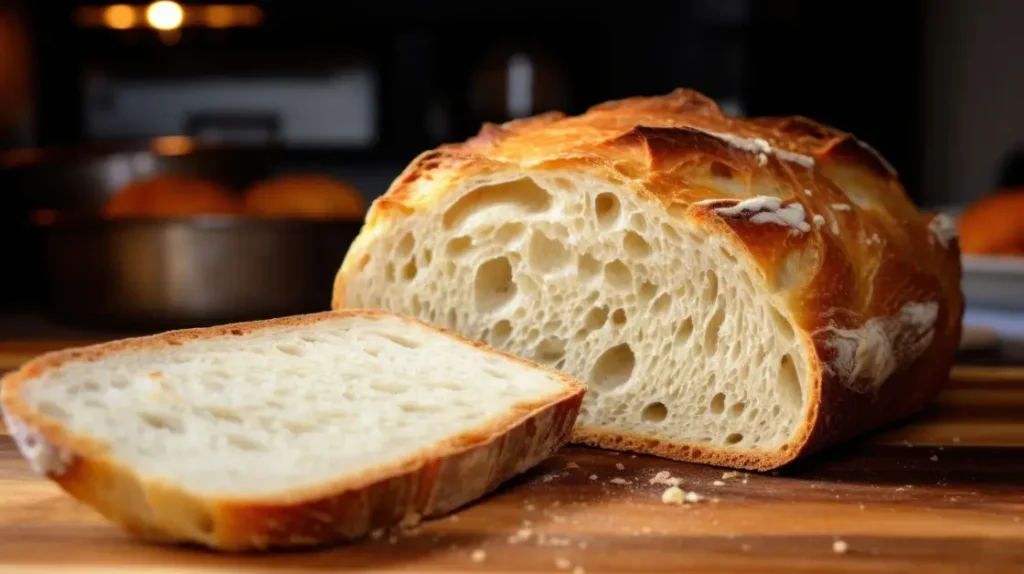
Once your batard bread is out of the oven and cooling, the hardest part is waiting. But the best part comes when it’s time to slice and serve! Whether you’re enjoying it as a side to a meal or making it the star of the show, batard bread is versatile and can be paired with countless dishes. Here are some serving suggestions to help you get the most out of your freshly baked loaf:
1. Perfect for Dipping
One of the simplest and most satisfying ways to enjoy batard bread is by serving it with olive oil and balsamic vinegar for dipping. The rich, nutty flavor of the olive oil complements the tangy crumb of the bread, creating a perfect balance. Add a pinch of sea salt or fresh herbs like rosemary for an extra layer of flavor.
2. Sandwiches, Anyone?
Batard bread’s slightly chewy, airy texture makes it the ideal candidate for sandwiches. Try it with a classic combination like turkey, cheese, and mustard, or go for something more adventurous like roasted vegetables and hummus. The shape of the loaf makes it easy to slice into hearty, satisfying portions.
3. Serve with Soups and Stews
Batard bread’s crusty exterior is perfect for dunking in soups, stews, and sauces. Whether it’s a comforting bowl of tomato soup or a rich, hearty beef stew, this bread will soak up all those delicious flavors without falling apart. It’s especially great for rustic dishes that benefit from a bit of texture. For another hearty bread option to pair with soups, check out our Marble Rye Bread recipe.
4. Cheese Pairings
Batard bread pairs beautifully with cheese. Its mild, slightly tangy flavor enhances the richness of aged cheeses like cheddar, Brie, or Gouda. For a fun twist, serve it with a cheese board featuring your favorite cheeses, some fresh fruit, and a drizzle of honey.
5. Toasted for Breakfast
If you have leftover batard bread, don’t worry it makes a fantastic breakfast the next morning! just cut it into thick slices and toast until it’s beautifully golden and crisp. Top with butter and jam, or go for a savory option with avocado, a sprinkle of salt, and a dash of red pepper flakes. It’s an easy way to make your morning meal feel a little more special. If you love breakfast breads, check out our Banana Nut Bread Recipe for another delicious option!
6. Bread for Charcuterie
Looking to impress your guests? Serve your batard bread alongside a charcuterie board. The bread’s texture pairs wonderfully with cold cuts, pâtés, and olives. Its oblong shape makes for easy slicing, and the crispy crust will add that extra crunch to every bite.
No matter how you serve it, batard bread is sure to be a crowd-pleaser. Its versatility makes it perfect for any occasion, from a casual dinner to a more formal gathering. So go ahead, slice that loaf, and enjoy the delicious results of your hard work!
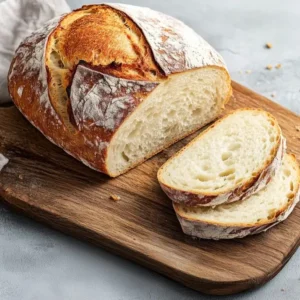
Perfect Batard Bread Recipe – Easy and Delicious
Ingredients
Levain (Sourdough Starter) :
- 20 g 1 heaping tablespoon sourdough starter (100% hydration)
- 80 g ⅓ cup water
- 80 g ⅔ cup bread flour
For the Batard Bread Dough :
- 100 g levain prepared in advance
- 360 g 1 ½ cups water (room temperature)
- 500 g 4 cups bread flour
- 2 teaspoons salt
- Olive oil for greasing the bowl
- 3 tablespoons rice flour for dusting the banneton
Instructions
Prepare the Levain
- Mix 20 g sourdough starter, 80 g water, and 80 g bread flour in a bowl.
- Stir until smooth, cover, and leave at room temperature for about 12 hours or until it’s bubbly and active.
Autolyse the Dough
- In a large bowl, combine 100 g of your levain with 360 g of water.
- Add 500 g of bread flour and mix gently until combined.
- Cover and let it rest for 45 minutes.
Add Salt and Mix
- Sprinkle 2 teaspoons of salt over the dough and mix thoroughly.
- Use your hands or a spatula to ensure the salt is fully incorporated.
Fold the Dough
- Grease a bowl with olive oil and transfer the dough into it.
- Cover and let it rest for 45 minutes.
- For the next 2 hours, fold the dough every 30 minutes. Gently stretch and fold the dough, rotating around it as you go.
Pre-Shape the Dough
- On a lightly greased surface, shape the dough into a rough batard shape by folding the top third and bottom third of the dough towards the center.
- Pinch the seam to seal and flip the dough seam-side down. Gently tuck the ends underneath and create tension on the surface.
Final Shaping and Proofing
- Dust a banneton with rice flour and place the dough seam-side up inside.
- Cover and refrigerate overnight (12-16 hours). This slow fermentation will enhance the flavor.
Preheat the Oven and Bake
- Set your oven to 450°F (230°C) and place the dutch oven inside to heat for 45 minutes.
- Take the dough out of the fridge and carefully flip it onto a sheet of parchment paper.
- Use a sharp blade or lame to make shallow cuts across the top of the dough.
- Carefully transfer the dough into the hot dutch oven and place the lid on top.
Bake the Batard
- Bake for 25 minutes with the lid on.
- After 25 minutes, take off the lid and continue baking for another 20 minutes, or until the bread turns a golden brown.
- Move the bread to a cooling rack and allow it to cool for at least an hour before slicing.
Notes
- Calories: 210 kcal
- Fat: 1.5g
- Protein: 4g
- Carbohydrates: 24g
- Fiber: 1g
- Sodium: 250mg
7. Recipe FAQs
As you embark on your batard bread baking journey, you might have a few questions along the way. Don’t worry, I’ve got you covered! Here are some of the most frequently asked questions about batard bread, along with answers to help clarify any doubts you might have:
What is a batard bread?
Batard bread is a French artisan loaf that shares similarities with baguettes but is shorter and thicker. It has a soft, chewy crumb with a golden, crisp crust. The batard is slightly oblong in shape, making it perfect for slicing and serving with a variety of dishes. It’s known for its delightful texture and slightly tangy flavor, thanks to the long fermentation process.
What size is a batard loaf?
A batard loaf is typically shorter than a baguette but still quite substantial. It usually measures about 12-14 inches in length and 4-5 inches in width, making it the perfect size for serving at meals or creating sandwiches. Its size is also ideal for shaping by hand, and it’s a great loaf for slicing into thicker or thinner pieces depending on your preference.
How do you cut batard bread?
To cut batard bread, use a sharp serrated knife to ensure you get clean, even slices without squashing the bread. Start by cutting the loaf in half, then slice from there. The batard’s chewy crumb and crunchy crust make it perfect for thicker slices, but feel free to slice it as thinly or thickly as you like for different uses.
Is batard a sourdough?
Batard bread can indeed be made as sourdough, particularly if you use a sourdough starter for the levain (the pre-ferment). The sourdough starter gives the bread its characteristic tangy flavor. However, not all batard bread is made as sourdough some recipes may use commercial yeast instead of a starter for a milder flavor.
What is the difference between batard and boule bread?
The main difference between a batard and a boule lies in their shape. A boule is round and typically larger, while a batard is more oval and elongated. Boule bread has a more rustic appearance, while batard bread is more compact and easier to slice. Both types of bread can have similar textures and flavors, especially when made with sourdough starter, but the boule tends to be a bit more airy due to its round shape.
Can I use regular yeast instead of sourdough starter?
Yes, you can use regular yeast instead of a sourdough starter if you’re looking for a quicker option. While the flavor profile will be slightly different, you can achieve a similar texture and crust. Simply use about 2 teaspoons of active dry yeast in place of the sourdough starter and adjust the fermentation times accordingly.
How long does batard bread last?
Batard bread is best enjoyed fresh, but it will last for about 2-3 days if stored properly. To keep it fresh, store it in a paper bag or a bread box to allow the crust to stay crispy. You can also freeze slices for longer storage just make sure to wrap them tightly in plastic wrap and foil.
Why is my batard bread dense?
If your batard bread turns out dense, it could be due to a few factors:
Under-proofing: The dough might not have risen enough, so be sure to give it plenty of time to ferment and rise.
Too little water: If the dough is too dry, it can result in a denser loaf. Ensure you’re using the right hydration levels and that your flour absorbs the water properly.
Overworking the dough: Be gentle with your dough, especially when shaping it.

